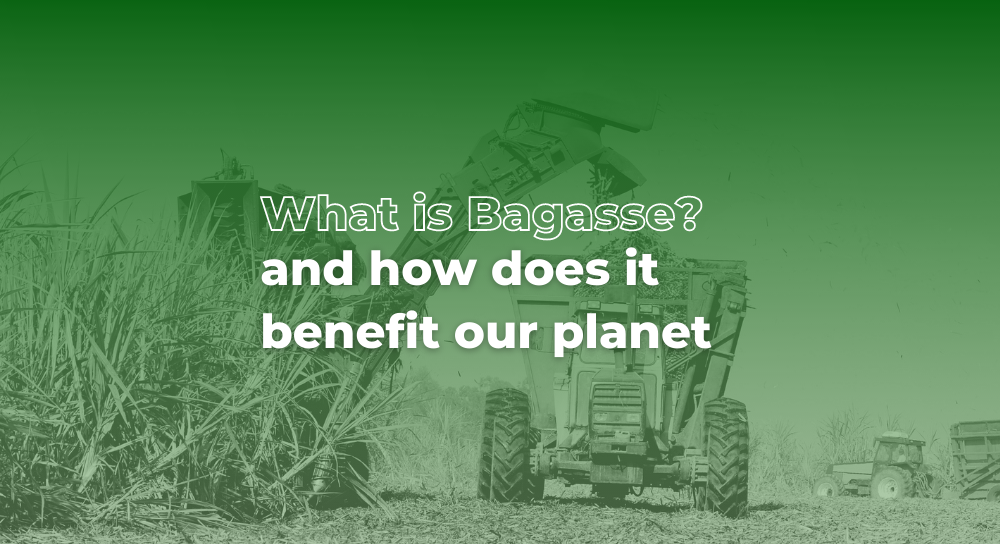
Let’s begin with the simple stuff. It’s pronounced “ba-gah-say.” What exactly is it? Bagasse is a kind of plant fibre. It is, more particularly, the fibrous stuff that remains after the production of sugarcane, sorghum, or agave. In a nutshell, it is bio-waste. Bagasse was traditionally viewed as useless and disposable – tossed away, burned, or allowed to decay in open mounds. It was not regarded as a valuable byproduct. Fortunately, things have changed and bagasse is now seen for the useful, renewable resource that it is. It is being employed for a variety of purposes across the world, including power generation, tree-free paper manufacture, and in some places, as a viable foundation for cattle feed.
Did you know Bagasse is being utilised as a fuel source for sugar mills? When burned in sufficient quantity, it provides enough heat energy to meet all of the demands of a conventional sugar mill with energy to spare. Bagasse is used as a energy source all over the world to create both heat and electricity, which is then sold back to the consumer power grid.
Although there has been some controversy about the subsequent carbon dioxide (CO2) emissions from such a power station, the CO2 emissions are equivalent to the amount of CO2 absorbed from the environment by the sugarcane plant during its growth phase, meaning the impact on climate gases is neutral. Sugar mills generate a considerable amount of ‘green’ power to the total electrical supply in several countries (including Australia). Florida Crystals, one of America’s major sugar corporations, owns and runs North America’s largest biomass power facility. Bagasse is used to create power for the facility’s milling and refining processes, as well as renewable electricity for almost 60,000 homes.
Bagasse is a good replacement for many items that were formerly created from trees (wood pulp or fibre) and even certain polymers. To illustrate our point, consider a standard paper plate that you may use for a picnic. Trees are plants that can be replanted, but it takes a long time for the tree to mature to the point where it can be harvested. When we cut down a forest, we damage the entire ecology. Instead of using agricultural crop byproducts for paper manufacture, we can reuse those resources in a single growing season with significantly less impact on the environment.
Let’s face it: destroying our forests for commercial paper stock just doesn’t make sense – we’re losing 80,000 acres of forest and rainforest every day. Oh, and guess what else? To make paper plates more resistant to oily or wet meals requires a petroleum-based coating, rendering it non-compostable and far more difficult to recycle.
So what if you use plastic or foam (Styrofoam) plates? Well, first of all, you are using a product made from petroleum which is a non-renewable resource. Right now we need that petroleum for power and to move our planes, trains and automobiles. The problems with petroleum extraction to make plastic and polystyrene are even more far-reaching. Think: oil spills, landfill failures, greenhouse gas emissions and the growing problems related to hydraulic horizontal drilling for natural gas (aka fracking).
These are only a handful of environmental issues. Add to that the growing amount of information showing health risks associated with the use of chemicals in petroleum-based goods, and it’s clear that plastics and foam aren’t the answer. Bagasse, on the other hand, is becoming recognised as a very helpful alternative to levelling our forests and mining our nonrenewable resources all over the world.
Bagasse is inherently grease and cut resistant, microwaveable and freezer safe. It can endure temperatures as high as 200 degrees Fahrenheit but also readily biodegrades. It is accepted in commercial composting facilities for carbon sequestering in the composting process because it is a plant-based product. Most bagasse products may also be composted at home if they are chopped up first and the correct composting procedures are followed. Bagasse is so ideally positioned as a good substitute for traditional paper, plastic, and foam-based products that the range of consumer products made from it is growing. Bagasse is an excellent alternative for a variety of products including tissue, newspaper, dinnerware, writing paper, and many more.
PO Box 598 Nambour QLD 4560 Australia